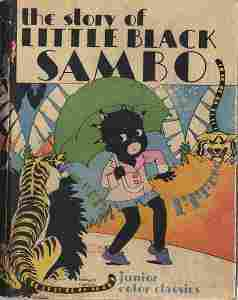Little Black Sambo
 From Conservapedia
From Conservapedia 
The Story of Little Black Sambo is a short children's book[1] by Helen Bannerman, a Scottish national. Helen Bannerman went on to write many similar books. The book was first published in 1899 and features the hero, Sambo, outwitting four hungry tigers by trading his colorful clothes and umbrella in return for his safety. The tigers then are defeated by their own vanity, as each bites the next one's tail forming a ring. Objections which surfaced in the mid 20th century[2] are primarily to the illustrations and to the protagonist's name, not to the story itself.[3]
- White readers tend to focus on Bannerman's non-racist intentions and the unfairness of judging yesterday's "classics" by today's standards of racial equality. Blacks find the book's title and the illustrations offensive.[4]
The story takes place in a mythical India and the tigers racing around the tree are turned into ghee, the Indian word for clarified butter, used to make pancakes for his family's supper.
Typical reviews suggest that the story well deserves its place in children's literature as a charming story of resourcefulness and bravery:
- The story has all the right elements: food, beautiful bright colors, a child not dependent on the grownups, a little fright, and a very happy ending, to make up a completely delightful and CHARMING story.
- I STILL LOVED, ADORED, and WAS CHARMED by the story in which a little boy with so much happiness and wits turn all the adversaries into delicious food! [5]
The story was a children's favorite for many years, but then became subject to a censorship campaign in certain countries based on complaints about outdated racial imagery.[6]
Contents
- 1 Racial stereotyping
- 2 Restaurant Chain
- 3 Notes
- 4 External links
Racial stereotyping[edit]
For a more detailed treatment, see stereotyping.
Langston Hughes wrote in 1932 that:
- Little Black Sambo exemplified the "pickaninny variety" of storybook, "amusing undoubtedly to the white child, but like an unkind word to one who has known too many hurts to enjoy the additional pain of being laughed at."[4]
A 1941 book and record version of the story "epitomizes the worst of racial stereotyping -- Sambo's parents are now Mammy and Pappy, for example, and they are caricatures of Aunt Jemima and Steppin' Fetchit." [6]
- Jerry Pinkney said in a recent lecture that LBS was one of his favorite books as a child because it showed a resourceful black kid. He suggested that the problems with the book stem primarily from the stereotypical illustrations and the connotation that later attached to the name Sambo.[5]
Barbara Bader wrote:
All American children did not see the same book, however. Though the authorized Stokes edition sold well and never went out of print, a host of other versions quickly began to appear from mass-market publishers, from reprint houses, from small, outlying firms unconstrained by the mutual courtesies of the major publishers. A few are straight knock-offs of the book that Bannerman made, without her name on the title page; the majority were reillustrated -- with gross, degrading caricatures that set Sambo down on the old plantation or, with equal distortiveness, deposited him in Darkest Africa. Libraries stocked the Stokes edition, and a few others selectively. But overall the bootleg Sambos were much cheaper, more widely distributed, and vastly more numerous.[4]
Restaurant Chain[edit]
The controversy over the book led to the closing of a chain of over 1,000 Sambo's restaurants. The restaurants had been named after its founders, Sam Battistone and Newell Bohnett, but the association with the story led activists to campaign for a name change, and the chain declared bankruptcy by the end of the 1970s. The flagship location remains in business in Santa Barbara, California.
Notes[edit]
- ↑ It has only 1,089 words.
- ↑ The anti-Little Black Sambo movement started in the 1930s and continued into the 1970s. Black educators and civil rights leaders organized numerous campaigns to get the book banned from public libraries, especially in elementary schools. [1]
- ↑ "Was Bannerman's Little Black Sambo racist? The major characters: Little Black Sambo, his mother (Black Mumbo) and his father (Black Jumbo) used standard English, not the bastardized English then associated with Blacks. Stereotypical anti-Black traits -- for example, laziness, stupidity, and immorality -- were absent from the book. Little Black Sambo, the character, was bright and resourceful unlike most portrayals of Black children." [2]
- ↑ 4.0 4.1 4.2 [3]
- ↑ 5.0 5.1 [4]
- ↑ 'While this story has charmed generations, current publishers have decided to avoid any sense of perceived negative connotations by reissuing the ORIGINAL storybook with a new title: "The Story of Little Babaji.' [5]
External links[edit]
- The Picaninny Caricature
Categories: [Children's Fiction]
↧ Download as ZWI file | Last modified: 02/23/2023 14:55:28 | 46 views
☰ Source: https://www.conservapedia.com/Little_Black_Sambo | License: CC BY-SA 3.0
 ZWI signed:
ZWI signed: KSF
KSF